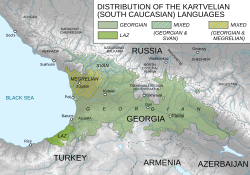Mingrelian language
| Mingrelian | |
|---|---|
| მარგალური ნინა margaluri nina | |
| Native to | Georgia |
| Region | Mingrelia Abkhazia |
| Ethnicity | Mingrelians |
Native speakers | 345,000 (2015)[1] |
| Georgian script | |
| Language codes | |
| ISO 639-3 | xmf |
| Glottolog | ming1252 |
| ELP | Mingrelian |
 | |
 Mingrelian is classified as Definitely Endangered by the UNESCO Atlas of the World's Languages in Danger | |
Mingrelian language, or Megrelian language (მარგალური ნინა, margaluri nina) is a Kartvelian language spoken in Western Georgia (regions of Mingrelia and Abkhazia), primarily by the Mingrelians. Mingrelian has historically been only a regional language within the boundaries of historical Georgian states and then modern Georgia, and the number of younger people speaking it has decreased substantially, with UNESCO designating it as a "definitely endangered language".[2]
Distribution and status
[edit]
No reliable figure exists for the number of native speakers of Mingrelian, but it is estimated to be between 300,000 and 500,000. Most speakers live in the Mingrelia (or Samegrelo and formerly Odishi) region of Georgia, which comprises the Odishi Hills and the Colchis Lowlands, from the Black Sea coast to the Svan Mountains and the Tskhenistskali River. Smaller enclaves existed in Abkhazia,[3] but the ongoing civil unrest there has displaced many Mingrelian speakers to other regions of Georgia. Their geographical distribution is relatively compact, which has helped to promote the transmission of the language between generations.
Mingrelian is generally written in the Georgian alphabet, but it has no written standard or official status. Almost all speakers are bilingual; they use Mingrelian mainly for familiar and informal conversation, and Georgian (or, for expatriate speakers, the local official language) for other purposes.
History
[edit]Mingrelian is one of the Kartvelian languages. It is closely related to Laz, from which it has become differentiated mostly in the past 500 years, after the northern (Mingrelian) and southern (Laz) communities were separated by Turkic invasions. It is less closely related to Georgian, the two branches having separated in the first millennium BC or earlier, and even more distantly related to Svan, which is believed to have branched off in the 2nd millennium BC or earlier.[4] Mingrelian is mutually intelligible only with Laz.
Some linguists refer to Mingrelian and Laz as Zan languages.[5] Zan had already split into Mingrelian and Laz variants by early modern times, however, and it is not customary to speak of a unified Zan language today.
The oldest surviving texts in Mingrelian date from the 19th century, and are mainly items of ethnographical literature. The earliest linguistic studies of Mingrelian include a phonetic analysis by Aleksandre Tsagareli (1880), and grammars by Ioseb Kipshidze (1914) and Shalva Beridze (1920). From 1930 to 1938 several newspapers were published in Mingrelian, such as Kazakhishi Gazeti, Komuna, Samargalosh Chai, Narazenish Chai, and Samargalosh Tutumi. More recently, there has been some revival of the language, with the publication of a Mingrelian–Georgian dictionary by Otar Kajaia, a Mingrelian-German dictionary by Otar Kajaia and Heinz Fähnrich, and books of poems by Lasha Gakharia, Edem Izoria, Lasha Gvasalia, Guri Otobaia, Giorgi Sichinava, Jumber Kukava, and Vakhtang Kharchilava, journal Skani, Mingrelian Wikipedia, as well as books and magazines published by Jehovah's Witnesses.[6]
Phonology
[edit]Vowels
[edit]Mingrelian has five vowel phonemes /i ɛ a ɔ u/. The Zugdidi-Samurzaqano dialect has a sixth /ə/ which is the result of assimilation of /i/ and /u/.
| Front | Back | ||
|---|---|---|---|
| unrounded | rounded | ||
| High | i [i] ი | (ə [ə]) ჷ | u [u] უ |
| Mid | e [ɛ] ე | o [ɔ] ო | |
| Low | a [ɑ] ა | ||
Consonants
[edit]The consonant inventory of Mingrelian contains series of aspirated and ejective consonants that contrast with voiced consonants. The inventory and is almost identical to that of Laz, Georgian, and Svan. The table below shows the consonants of Mingrelian in romanized script, phonetic symbols from the IPA, and in Mkhedruli script.
| Labial | Alveolar | Palatal | Velar | Uvular | Glottal | ||
|---|---|---|---|---|---|---|---|
| Nasal | m [m] მ | n [n] ნ | |||||
| Plosive | voiced | b [b] ბ | d [d] დ | g [ɡ] გ | |||
| aspirated | p [pʰ] ფ | t [tʰ] თ | k [kʰ] ქ | ||||
| ejective | p̌ [pʼ] პ | ţ [tʼ] ტ | ǩ [kʼ] კ | qʼ [qʼ] ყ | ɔ [ʔ] ჸ | ||
| Affricate | voiced | ž [d͡z] ძ | dj [d͡ʒ] ჯ | ||||
| aspirated | ʒ [t͡sʰ] ც | ç [t͡ʃʰ] ჩ | |||||
| ejective | ǯ [t͡sʼ] წ | č [t͡ʃʼ] ჭ | |||||
| Fricative | voiced | v [v] ვ | z [z] ზ | j [ʒ] ჟ | ɣ [ɣ] ღ | ||
| voiceless | s [s] ს | ş [ʃ] შ | x [x] ხ | h [h] ჰ | |||
| Trill | r [r] რ | ||||||
| Approximant | l [l] ლ | y [j] ჲ | |||||
Phonetic processes
[edit]Vowel reduction
[edit]Certain pairs of vowels reduce to single vowels:[clarification needed]
- ae and ai → ee → e
- ao, oa and oo → aa → a
- ou → uu → u
In Zugdidi-Samurzaqano dialect the vowels i and u also often reduce to ə.
Pre-consonant change of velar g
[edit]Before consonants, g → r.
Positional change of uvular q' sound
[edit]In word-initial prevocalic and intervocalic positions, q' → ʔ. Before the consonant v, q' → ɣ/ǩ.
Regressive assimilation of consonants
[edit]The common types are:
- voicing/devoicing of voiceless/voiced consonants before voiced/voiceless ones (respectively).
- glottalization of consonants before the glottalized ones and the glottal stop.
Progressive dissimilation
[edit]If the stem contains r then the suffixes -ar and -ur transform to -al and -ul, e.g. xorga (Gaghma Pirveli Khorga, the village)→ xorg-ul-i ("Khorgan"). The rule is not valid if in the stem with r an l appears later, e.g. marṫvili ("Martvili", the town) dj marṫvil-ur-i (adj. "Martvilian")
In a stem with voiceless affricates or voiceless sibilants, a later ǯ is deaffricated to d, e.g. orcxondji dj orcxondi "comb", ç̌andji dj ç̌andi "fly (insect)", isindji dj isindi "arrow", etc.
The transformation of l
[edit]- in all dialects of Mingrelian, before consonants l → r.
- in the Martvili subdialect in word-initial prevocalic position, l → y → ∅ and in intervocalic position l → ∅ [further explanation needed]
Intervocalic deletion of v
[edit]Between the vowels the organic[clarification needed] v disappears, e.g. xvavi (Geo. "abundance, plenty") → *xvai → xvee (id.), mṭevani (Geo. "raceme") → ţiani (id.), etc.
Phonetic augmentation n
[edit]Before the stops and affricates, an inorganic[clarification needed] augmentation n may appear (before labials n → m).
Mingrelian orthography
[edit]Mingrelian is written in Mkhedruli, Latin and Cyrillic scripts. The spelling using the Mkhedruli script uses symbols not used in Georgian : ⟨ჲ ჷ ჸ⟩ to represent /j ə ʔ/, respectively.
| Mkhedruli | Mingrelian Latin | Mingrelian Cyrillic | IPA transcription |
|---|---|---|---|
| ა | a | а | ɑ |
| ბ | b | б | b |
| გ | g | г | ɡ |
| დ | d | д | d |
| ე | e | е | ɛ |
| ვ | v | в | v |
| ზ | z | з | z |
| თ | t | ꚋ | t |
| ი | i | і | i |
| კ | ǩ | к | kʼ |
| ლ | l | л | l |
| მ | m | м | m |
| ნ | n | н | n |
| ჲ | y | ј | j |
| ო | o | о | ɔ |
| პ | p̌ | п | pʼ |
| ჟ | zh | ж | ʒ |
| რ | r | р | r |
| ს | s | с | s |
| ტ | ṫ | т | tʼ |
| უ | u | у | u |
| ჷ | ƨ | ѵ | ə |
| ფ | p | ҧ | p |
| ქ | k | ӄ | k |
| ღ | ǧ | ҕ | ɣ |
| ყ | q̌ | k | qʼ |
| ჸ | ɔ | ɣ | ʔ |
| შ | ş / sh | ш | ʃ |
| ჩ | ç / ch | ч | t͡ʃ |
| ც | ʒ / ts | ц | t͡s |
| ძ | dz | ӡ | d͡z |
| წ | ǯ / tz | ҵ | t͡sʼ |
| ჭ | ç̌ | ꚓ | t͡ʃʼ |
| ხ | x | х | x |
| ჯ | dj | џ | d͡ʒ |
| ჰ | h | һ | h |
Grammar
[edit]Dialects
[edit]The main dialects and subdialects of Mingrelian are:
- Zugdidi-Samurzakano or Northwest dialect
- Jvari
- Senaki-poti or Southeast dialect
- Martvili-Bandza
- Abasha
Famous speakers
[edit]- Lavrenti Beria, Soviet leader Joseph Stalin's chief of secret police
- Konstantine Gamsakhurdia, one of the most influential Georgian writers of the 20th century
- Zviad Gamsakhurdia, first president of post-Soviet Georgia
- Antisa Khvichava, claimed world's oldest person (purportedly 132 years old at the time of her death in 2012).[7]
- Khvicha Kvaratskhelia, Georgian footballer
- Ilia Topuria, Spanish and Georgian mixed martial artist
References
[edit]- ^ Mingrelian at Ethnologue (19th ed., 2016)

- ^ "UNESCO Atlas of the World's Languages in Danger". UNESCO. Retrieved 4 April 2018.
- ^ "Georgia". U.S. Department of State. First paragraph, third sentence. Retrieved 9 April 2016.
The United States supports Georgia's sovereignty and territorial integrity within its internationally recognized borders, and does not recognize the Abkhazia and South Ossetia regions of Georgia, currently occupied by Russia, as independent.
- ^ Schulze, Wolfgang (2009). "Languages in the Caucasus" (PDF).
- ^ "K2olxuri Ena (Colchian Language)". Archived from the original (DOC) on March 1, 2012.
- ^ "იეჰოვაშ მოწმეეფიშ გიშაშკუმალირი ბიბლიური წიგნეფი დო ჟურნალეფი". jw.org. Retrieved 4 April 2018.
- ^ Dzhindzhikhashvili, Misha (8 July 2010). "Georgia Claims it Has World's Oldest Person, 130". Yahoo! News. Associated Press. Archived from the original on 2010-07-12.
Further reading
[edit]- Amirejibi, Rusudan (2006). Kʻolkhuri (Megrul-Lazuri) Ena (PDF). Gamomcʻemloba "Universali". ISBN 99940-61-43-7.
- Beridze, Shalva (1920). Megruli (Iveriuli) Ena [Megrelian (Iverian) Language] (in Georgian).
- Broers, Laurence (2012). "'Two Sons of One Mother'. Nested Identities and Centre-Periphery Politics in Post-Soviet Georgia". In Schonle, Andreas; Makarova, Olga; Hicks, Jeremy (eds.). When the Elephant Broke Out of the Zoo. A Festschrift for Donald Rayfield. Stanford Slavic Studies. Vol. 39. ISBN 9781572010888.
- Kʻajaia, Otʻar (2001–2002). Megrul-kʻartʻuli lekʻsikoni [Mingrelian-English Dictionary]. Gamomcʻemloba "Nekeri", Tʻbilisi. OCLC 50676816.
- Kipshidze, Ioseb (1914). Grammatika mingrelʹskogo (iverskogo) i͡azyka [Grammar of Megrelian (Iverian) Language] (in Russian).
- Kʻobalia, Alio; Čʻuxua, Merab; Kʻobalia, Nana (2010). Megruli Leksikʻoni. Gamomcʻemloba Artanuji. ISBN 9789941421143.
- Tsargareli, Aleksandre (1880). Megrelʹskie ėti͡udy, Analiz fonetiki megrelʹskogo i͡azyka [Megrelian Studies — The Analysis of Phonetics of Megrelian Language] (in Russian).



